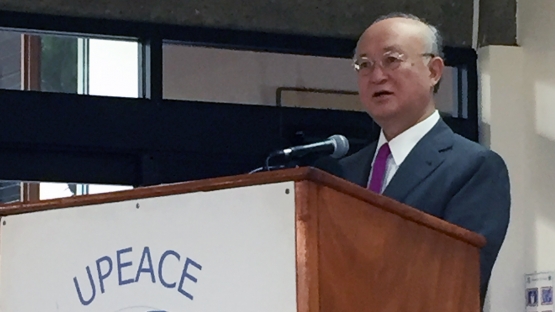While the IAEA may be best known for its work in helping to prevent the spread of nuclear weapons, its mandate and impact go beyond non-proliferation, Director General Yukiya Amano said at the University for Peace in San José, Costa Rica, yesterday.
In Central America, for example, the IAEA has helped to reduce insect pest populations with the sterile insect technique and advised governments in several countries, including Costa Rica, on the implementation of their national plans on cancer prevention and control, Mr Amano said. He noted that more than 130 Costa Rican scientists have benefitted from fellowships or scientific visits to the IAEA’s nuclear applications laboratories near Vienna.
The IAEA works closely with Costa Rica in peaceful uses of nuclear technology. In the next two years, it will help to establish a biological dosimetry laboratory at the University of Costa Rica, strengthen radiotherapy and nuclear medicine capabilities in the country’s hospitals, and help manage water supplies using isotope tracer techniques. “We greatly value our cooperation with Costa Rica and look forward to strengthening it in the coming years,” Mr Amano said.
He highlighted the importance of the peaceful uses of nuclear science and technology, which is also recognized by the United Nations Sustainable Development Goals (SDGs). The IAEA will play an important role in helping countries to achieve the SDGs. “The IAEA has been contributing effectively to sustainable development for nearly 60 years,” he said.
During his three-day trip to Costa Rica, Mr Amano also visited the Health Research Institute (INISA) of the University of Costa Rica and opened a new building at the university’s Atomic Nuclear and Molecular Science Research Centre (CICANUM). He was scheduled to meet Costa Rica’s Vice President and the Minister for Science and Technology, and to inaugurate an irradiation machine at the Materials Science and Engineering School (TEC) in Cartago, near the capital.
Visiting Central America
Mr Amano is on a two-week visit to Central America. He visited Panama before travelling to Costa Rica, and was due to travel on to El Salvador, Nicaragua, Guatemala and Mexico. During his meetings, he has pointed to the important collaboration between the IAEA and the countries of Central America in areas such as combating cancer, the sterile insect technique and the protection of the environment. He has also discussed ways in which IAEA technology could help to reduce the population of mosquitoes that carry the Zika and other viruses.



